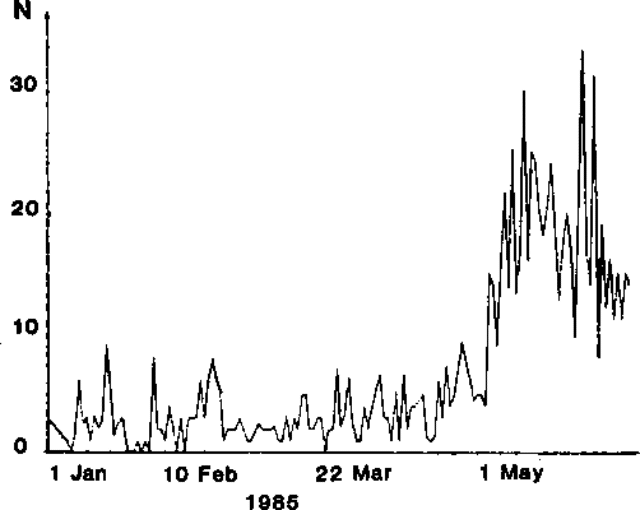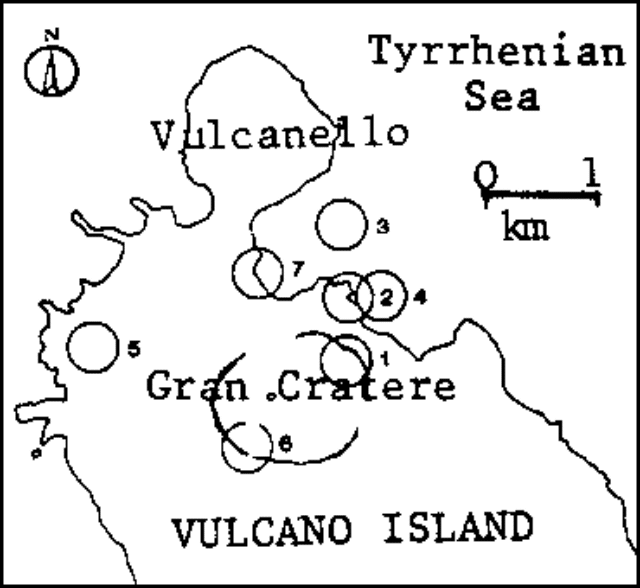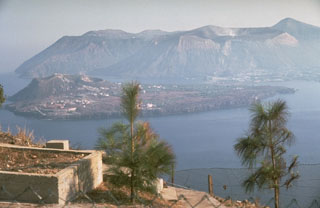Report on Vulcano (Italy) — June 1985
Scientific Event Alert Network Bulletin, vol. 10, no. 6 (June 1985)
Managing Editor: Lindsay McClelland.
Vulcano (Italy) Microearthquake swarm and slight uplift
Please cite this report as:
Global Volcanism Program, 1985. Report on Vulcano (Italy) (McClelland, L., ed.). Scientific Event Alert Network Bulletin, 10:6. Smithsonian Institution. https://doi.org/10.5479/si.GVP.SEAN198506-211050
Vulcano
Italy
38.404°N, 14.962°E; summit elev. 500 m
All times are local (unless otherwise noted)
"Daily earthquake frequency in the Vulcano area showed, from 24 April, a significant increase (figure 1). Seismic energy may also be considered unusual even though magnitudes have not exceeded 2.5. Epicenters lay predominantly in the Gran Cratere area or very close to it (figure 2); focal depths were generally <1 km. The timing of event and energy distribution reveals the swarm character of the seismicity. Waveforms lead us to hypothesize that both degassing and fracturing phenomena occurred. A leveling survey carried out in May showed a slight uplift (1 cm) of the epicentral area with respect to the S part of the island."
 |
Figure 1. Daily frequency of local earthquakes recorded 1 January-30 May 1985 by the Vulcano Cratere seismic station on the N flank. Courtesy of IIV. |
 |
Figure 2. Epicenters of the seven highest energy earthquakes that occurred in the Vulcano area 24 April-30 May 1985. Courtesy of IIV. |
Further References. Frazzetta, G., Gillot, P.Y., La Volpe, L., and Sheridan, M.F., 1984, Volcanic hazards at fossa of Vulcano: Data from the last 6000 years: BV, v. 47, p. 105-125.
Falsaperla, S., and Neri, G., 1986, Seismic monitoring of volcanoes: Vulcano (southern Italy): Periodico di Mineralogia, v. 55, p. 143-152.
Geological Summary. The word volcano is derived from Vulcano stratovolcano in Italy's Aeolian Islands. Vulcano was constructed during six stages over the past 136,000 years. Two overlapping calderas, the 2.5-km-wide Caldera del Piano on the SE and the 4-km-wide Caldera della Fossa on the NW, were formed at about 100,000 and 24,000-15,000 years ago, respectively, and volcanism has migrated north over time. La Fossa cone, active throughout the Holocene and the location of most historical eruptions, occupies the 3-km-wide Caldera della Fossa at the NW end of the elongated 3 x 7 km island. The Vulcanello lava platform is a low, roughly circular peninsula on the northern tip of Vulcano that was formed as an island beginning more than 2,000 years ago and was connected to the main island in about 1550 CE. Vulcanello is capped by three pyroclastic cones and was active intermittently until the 16th century. Explosive activity took place at the Fossa cone from 1898 to 1900.
Information Contacts: S. Falsaperla and G. Neri, IIV.

